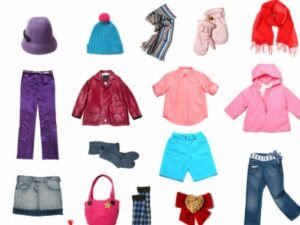If you’re reading this, there’s a good chance you’re thinking about starting your own children’s clothing line. And why not? It’s a lucrative industry that’s only growing in popularity. But before you take the plunge, there are a few things you need to know.
There are simple tips, like how to choose the right name for your brand or how to find the perfect manufacturer. But there are also more complicated aspects to starting a clothing line, like understanding the difference between wholesale and retail or learning how to create a marketing strategy.
In this article, we’ll cover all of that and more. So whether you’re just starting to think about starting a children’s clothing line or you’re already in the thick of it, this guide will give you the information you need to get started. Let’s get started!
Step #1 Do Your Research
The first step to starting your own children’s clothing line is to do your research. This means learning about the industry, children’s clothing industry analysis, what it takes to start a clothing line, and what your target market is. There are a number of resources available online and in libraries that can help you with this research.

You can do your research using these resources:
Internet Resources
Use Google and other search engines to find information about starting your own clothing line. This is a great way to find general information about the industry and get an overview of what you need to do.
There are also many forums and message boards dedicated to starting your own clothing line where you can ask questions and get advice from other entrepreneurs.
Industry Research Reports
There are several industry research reports available that provide detailed information about the children’s clothing industry. These reports can be found online or through business databases.
Business Journals
There are also several business journals that provide good information about starting your own clothing line. These include Entrepreneur, BusinessWeek, and Forbes. You can find these journals at your local library or online.
Industry Publications
There are also several industry publications that provide information about the children’s clothing industry. These can be found online and in print and can be a great resource for information about the business.
Trade Associations
Another good source of information about the children’s clothing industry is trade associations. These organizations can provide you with industry statistics, contact information for industry members, and other resources.
Books About Starting A Clothing Line
There are also several books available that provide information about how to start your own clothing line. These books can be found at your local library or online.
By doing your research, you will be able to learn about the industry, what it takes to start a clothing line, and what your target market is. This information will be invaluable as you start your own children’s clothing line.
Step #2 Choose a Niche
Before you can start your own children’s clothing line, you need to choose a niche. Will you focus on high-end designer clothes, affordable everyday wear, or something in between? Once you’ve decided on your target market, you can start researching the competition and developing a unique selling proposition.
Keep in mind that the children’s clothing market is notoriously competitive, so you’ll need to work hard to stand out from the crowd. But with a bit of planning and some creative thinking, you can create a successful children’s clothing line that will capture the hearts and minds of parents and kids alike.
Here are a few things to consider when choosing your niche:
Type Of Clothes You Want To Sell
You’ll need to decide what type of clothes you want to sell. Do you want to focus on a certain age group, such as newborns or toddlers? Perhaps you could specialize in a certain type of clothing, like party clothes or formal wear. Once you’ve decided on your niche, you’ll need to choose a name for your children’s clothing line that reflects this.

Age Of The Children You Want To Target
Another important consideration is the age of the children you want to target. Will you focus on newborns, toddlers, kids, or tweens? Each age group has its own set of needs and wants, so you’ll need to tailor your clothing line accordingly.

Price Point Of Your Clothes
When starting a children’s clothing line, you’ll also need to decide on a price point for your clothes. Will you focus on high-end designer clothes, affordable everyday wear, or something in between? Keep in mind that the price point you choose will directly impact your target market.

By taking the time to choose a niche, you’ll be able to focus your efforts and create a children’s clothing line that is unique and appealing to your target market.
Step #3 Find a Manufacturer
One of the critical steps in launching your own children’s clothing brand is discovering how to find clothing manufacturer such as a kids wear manufacturer such as Hongyu Apparel. This is the company that will be responsible for creating your clothing designs and getting them made into actual garments. There are a number of ways to find garment manufacturer, such as online directories, industry trade shows, and word-of-mouth.

Here are some of the important factors to consider when choosing a manufacturer:
Location
The first thing you’ll need to consider is the location of the private label clothing manufacturers. You’ll want to choose a company that is located in close proximity to your target market. This will help reduce shipping costs and lead times.
Experience
Another important factor to consider is the experience of the manufacturer. You’ll want to choose a company that has experience in manufacturing children’s clothing. This will ensure that they have the knowledge and expertise necessary to produce high-quality garments.
Cost
Of course, you’ll also need to consider the cost of working with the manufacturer. You’ll want to get quotes from a few different companies before making your final decision.
If you want to create high-quality garments, it’s important to choose the right manufacturer. This way, you can be sure that they’ll meet your specific needs and requirements.
Step #4 Create a Business Plan
Before you do anything else, it’s important to create a business plan for your starting a children’s clothing business. This document will outline your business goals, how you plan on achieving them, and what resources you’ll need. Your business plan should be thorough and well-researched, as it will be used to secure funding and attract investors.
Here are some important factors that should be included in your business plan:
Executive Summary
This is a brief overview of your business plan that should include your business goals, how you plan on achieving them, and a summary of your financial needs.
Company Description
This section should provide an overview of your company, including its history, mission statement, and any unique selling points.
Market Analysis
In this section, you’ll need to conduct a thorough market analysis. This will involve researching your target market, your competition, and the current trends in the children’s clothing industry.
SWOT Analysis
After you’ve conducted your market research, you’ll need to do a SWOT (Strengths, Weaknesses, Opportunities, and Threats) analysis. This will help you identify your company’s strengths and weaknesses, as well as any opportunities or threats that may impact your business.
Marketing Strategy
In this section, you’ll need to outline your marketing strategy. This will include how you plan on promoting your clothing line, both online and offline.
Financial Needs
Finally, you’ll need to include a detailed financial plan. This should include how much money you’ll need to get started, how you plan on making money, and your long-term financial goals.
When starting a clothing line, it is important to consider the cost of doing so. There are a number of expenses you will need to cover, such as:
| Cost Factor | Cost Inclusion |
| Design and Production Costs | This includes the cost of designing and producing your clothing. |
| Marketing Costs | This includes the cost of marketing your clothing line to your target market. |
| Inventory Costs | This includes the cost of stocking your inventory and paying for shipping costs. |
| Staffing Costs | This includes the cost of hiring employees to help run your business. |
When budgeting for your clothing line, be sure to account for all of these costs. This will help ensure that you have the funds necessary to get your business up and running.
Creating a business plan may seem like a lot of work, but it’s an important step in starting your own children’s clothing line. By taking the time to create a detailed plan, you’ll be able to increase your chances of success.
Step #5 Secure Funding
If you want to start a children’s clothing line, you’ll need to secure funding. This could come from a number of sources, such as personal savings, loans, or investments. Once you have the funding in place, you can start to focus on the next steps of starting your clothing line.
Here are some tips for securing funding:
Create A Detailed Business Plan
As we mentioned earlier, one of the best ways to secure funding is to create a detailed business plan. This document will outline your business goals and how you plan on achieving them. Be sure to include financial projections and a marketing strategy.
Pitch Your Business Idea
Another way to secure funding is to pitch your business idea to potential investors. This could be done in a number of ways, such as through a business plan competition or by meeting with potential investors directly.
Research Grants And Other Funding Opportunities
There are a number of grants and other funding opportunities available for businesses in the fashion industry. Be sure to do your research and see if you qualify for any of these programs.
Use Crowdfunding Platforms
If you’re having trouble securing funding from traditional sources, you can always turn to crowdfund platforms. These platforms allow you to solicit donations or investments from the general public.
Approach Family And Friends
If you’re struggling to find funding, you can always approach your family and friends for help. They may be willing to invest in your business or provide a loan.
Starting a children’s clothing line can be a costly endeavor, so it’s important to secure funding before moving forward. By taking the time to research your funding options, you’ll be in a better position to get your business off the ground.
Step #6 Choose a Name and Logo
One of the most important aspects of any business is its name and logo. This is how customers will identify your brand, so it’s important to choose something that is catchy, memorable, and relevant to your brand. Once you have a name and logo, you can start to create marketing materials.
If you’re not sure where to start, there are plenty of online resources that can help you create a professional-looking logo, such as DesignEvo or Canva.
For inspiration, take a look at some of the most popular children’s clothing brands and see how they’ve branded themselves. Once you have a few ideas, narrow down your choices and test them out on family and friends to see what they think. The final decision should be based on what you feel best represents your brand.
Step #7 Create a Website
In today’s world, it’s essential to have an online presence for your business. This means creating a website for your children’s clothing line. Your website should be professional and well-designed, and it should include information about your products, contact details, and shipping information.
You can hire a web designer to create a website for you, or you can use a platform like WordPress to create a website yourself.

If you decide to create a website yourself, there are a few things you should keep in mind. Here are a few of them:
Visually Appealing
Your website should be visually appealing and easy to navigate. First impressions are everything, so make sure your website looks professional and put together. Use high-quality images and avoid using too much text.
Simplicity is key when it comes to website design. You want potential customers to be able to find what they’re looking for quickly and easily.
Easy to Use Shopping Cart
Your website should have an easy-to-use shopping cart. This is one of the most important features of your website as it will determine how easy it is for customers to purchase your products.
Make sure the checkout process is simple and straightforward. Avoid having too many steps or confusing customers with too much information.
Secure Payment Processing
Your website should have secure payment processing. This is important for two reasons: first, you want to protect your customers’ information; and second, you want to ensure that you receive payments for your products.
There are a few different options when it comes to payment processing. You can use a third-party provider such as PayPal or Stripe, or you can process payments directly through your website. Whichever option you choose, make sure you have a secure system in place.
Shipping and Returns Policy
Your website should have a shipping and returns policy. This will let customers know how much they can expect to pay for shipping, how long it will take for their order to arrive, and what your return policy is.
Make sure your shipping and return policy is clear and easy to find on your website. You don’t want customers to be confused or frustrated when trying to figure out how much it will cost to return an item.
Creating a website may seem like a daunting task, but with a little bit of effort, you can create a professional and stylish website for your children’s clothing line that will attract customers and make sales.
Step #8 Set up Social Media Accounts
Another important part of having an online presence is setting up social media accounts. This will allow you to connect with potential customers, promote your products, and build up your brand. You should start with the major platforms, such as Facebook, Twitter, and Instagram.
When setting up your accounts, be sure to use keywords that relate to your brand and products. This will help potential customers find you more easily. You should also make sure to post regularly and interact with your followers.
Building up a strong social media presence will take time and effort, but it is worth it. These platforms can be incredibly powerful marketing tools.
Step #9 Write a Marketing Plan
Once you have your website and social media accounts set up, it’s time to start marketing your children’s clothing line. This will involve creating a marketing plan that outlines your marketing goals, strategies, and budget. Your marketing plan should be designed to reach your target market and promote your brand in the most effective way possible.
There are many different marketing strategies you can use to promote your children’s clothing line. Some common strategies include:
Online Advertising
Advertising your children’s clothing line on websites and social media platforms that your target market is likely to visit.
Content Marketing
Creating and sharing informative and engaging content that promotes your brand and drives traffic back to your website. This can be in the form of blog posts, infographics, images, or videos.
Social Media Marketing
Leveraging social media platforms to connect with your target market and promote your brand. This can involve creating and sharing engaging content, running ads, or holding contests and giveaways.
Email Marketing
Sending promotional emails to a list of subscribers who have opted-in to receive your marketing messages.
Word-of-Mouth Marketing
Encourage customers and fans to spread the word about your children’s clothing line to their friends and family.
When creating your marketing plan, be sure to include a mix of online and offline marketing strategies. This will give you the best chance of reaching your target market and achieving your desired results.
It is also important to set a budget for your marketing efforts. This will ensure that you are not spending more money than you can afford on marketing and that you are using your resources in the most efficient way possible.
Step #10 Launch Your Clothing Line
After you’ve taken all of the necessary steps, it’s time to launch your children’s clothing line. This will involve promoting your products, getting sales, and fulfilling orders. It’s important to have a solid plan in place so that you can avoid any stressful surprises along the way.
There are a few different ways to launch your clothing line. Here are a few ideas to get you started:
Create A Buzz On Social Media
Social media is a great way to create awareness for your brand. Use platforms like Twitter, Facebook, and Instagram to share photos and information about your products. Make sure to use relevant hashtags so that people can easily find your line.
Hold A Launch Party
A launch party is a great way to get people excited about your clothing line. Invite friends, family, and influencers to check out your collection. Serve refreshments and offer discounts to encourage people to shop your line.
Sell At Pop-up Shops
Pop-up shops are temporary retail spaces that are popular with start-ups and small businesses. This is a great option if you don’t have the funds to open a brick-and-mortar store. Look for spaces in high-traffic areas like malls or busy streets.
These are just a few ideas to get you started. The most important thing is to have a plan in place so that you can launch your clothing line successfully. With a little hard work and determination, you’ll be on your way to success in no time!
Want to learn more on how to start your own clothing brand? Check this video for more tips:
2
Dive Deeper Into Our Resources
Still haven’t found what you’re looking for? Don’t hesitate to contact us. We’re available around the clock to assist you.
Conclusion
Starting your own children’s clothing line can be a great way to tap into a growing market. If you follow these steps, you’ll be well on your way to starting your own successful children’s clothing line. Just remember to do your research, focus on your target market, and create a well-rounded business plan. With these things in mind, you’ll be sure to set your clothing line up for success.
For more questions on how to start your children’s clothing line, or for help finding manufacturers, contact us at Hongyu Apparel today. We’re always happy to help new businesses get started!
 By Kiki
By Kiki